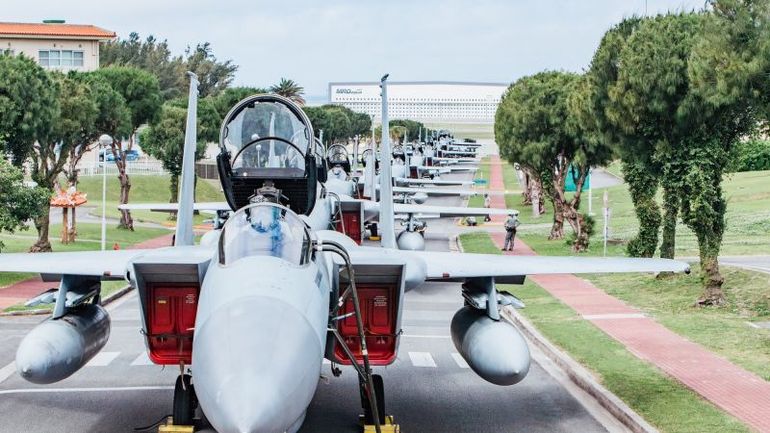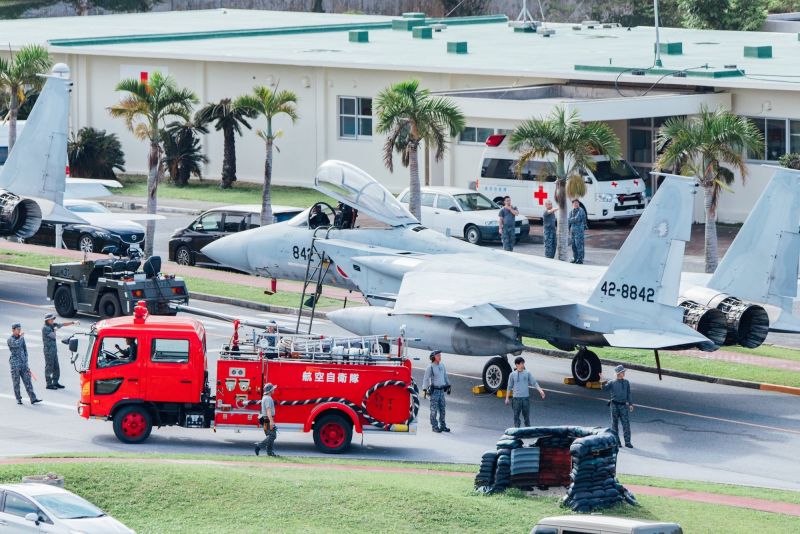
Japanese Air Force Faces Challenge After Taiwan Quake

The Japanese air force is accustomed to quick response drills for potential military threats, but how do they adapt when natural disasters like the Taiwan quake disrupt their operations? Discover the challenges faced by fighter pilots during unexpected situations.
Fighter pilots are trained to quickly take off in case of a military threat. But what happens when they need to face off against Mother Nature instead?
At a Japanese air base, they have a unique solution - they take to the streets.
After a powerful 7.4-magnitude earthquake struck near Taiwan last week, a tsunami alert was issued for Okinawa. In response, the Japan Air Self-Defense Force’s Naha Air Base, which is connected to the low-lying Naha Airport on the island's southwestern coast, took action by relocating twelve F-15J fighter jets to a two-lane road on higher ground.
Pictures shared on social media depicted a striking scene of air power in motion, as the dozen jets lined up along the road, occupying more than an eighth of a mile.
A spokesperson from the base explained to CNN that placing warplanes on a roadway instead of a runway is a common practice for the purpose of quick deployment.
The spokesperson mentioned that during a recent drill, it only took 15 to 20 minutes to relocate 12 fighter jets, demonstrating the effectiveness of regular evacuation exercises.
Aircraft tugs pulled the fighter jets on to a road at Naha Air Base on Okinawa to be sure they were not damaged in a possible tsunami.
Aircraft tugs pulled the fighter jets on to a road at Naha Air Base on Okinawa to be sure they were not damaged in a possible tsunami.
Naha Air Base
The F-15J, a variant of the US-designed F-15, is the “mainstay” of Japan’s air force, according to the country’s Defense Ministry.
The twin-engine jets are quite expensive, priced at around $30 million each. They weigh about 25 tons, have a wingspan of 43 feet (13.1 meters), and a length of nearly 64 feet (19.4 meters).
Although they are capable of flying at 2.5 times the speed of sound, during the tsunami alert, aircraft tugs were responsible for moving them.
When no damaging tsunami materialized, operations quickly returned to normal.
“They went back as all tsunami warnings were lifted,” the base spokesperson said.
Last week's quake not only impacted the Japanese military, but also affected Taiwan's Defense Ministry. According to reports, eight warplanes from Taiwan - six F-16s and two F-5s - received scratches during the earthquake.
The scratches on the aircraft were inspected and found to not affect its integrity. The Ministry stated that the repairs can be done right away without impacting combat readiness. The repairs were finished by Tuesday, as per the Ministry.
The quake, the strongest to hit Taiwan in 25 years, killed at least 13 people and injured more than 1,100 others.
CNN’s Wayne Chang contributed to this report.
Editor's P/S:
The quick response of the Japan Air Self-Defense Force in relocating their fighter jets to higher ground during the tsunami alert highlights the importance of preparedness and training. The fact that they were able to move 12 fighter jets in just 15-20 minutes demonstrates the effectiveness of their evacuation exercises. This incident also underscores the vulnerability of military assets to natural disasters, even in highly advanced countries like Japan.
The incident in Taiwan, where eight warplanes were damaged during the earthquake, serves as a reminder that natural disasters can have far-reaching consequences, affecting not only civilian populations but also military infrastructure. The fact that the scratches on the aircraft did not affect their integrity and were repaired quickly is a testament to the resilience of the Taiwanese military and their ability to respond to unexpected challenges.










